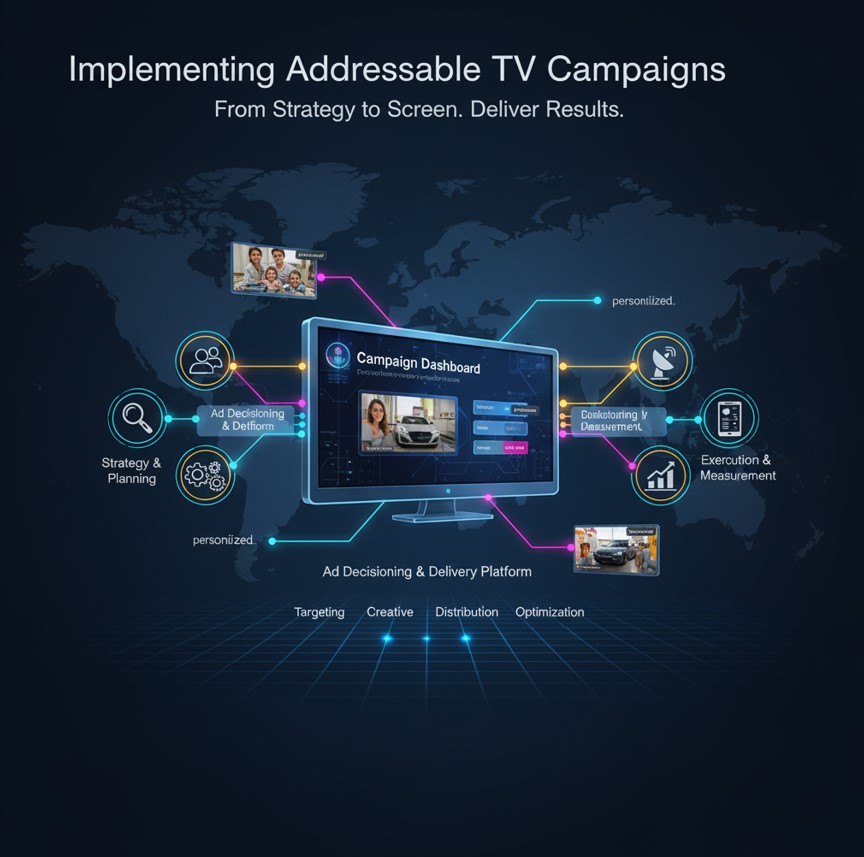What Is Addressable TV Advertising?
Addressable TV advertising leverages viewer data—such as demographics, purchase history, and viewing behavior—to serve different ads to different households tuning into the same program. Unlike linear TV, which broadcasts one creative to all viewers, addressable TV uses set-top boxes, smart TVs, or over-the-top (OTT) platforms to identify audience segments and dynamically insert tailored ads. The core advantage is relevance: audiences are more likely to engage with content that reflects their interests and needs, boosting ad effectiveness and brand affinity.
How Addressable TV Works
- Data Collection: First-party data from brands, second-party data from partners, and third-party data providers build audience profiles.
- Segment Definition: Advertisers define target groups based on attributes like age, income, lifestyle, and purchase intent.
- Ad Decisioning: At ad-break time, the addressable platform selects the appropriate creative variant for each household segment.
- Dynamic Insertion: Ads are swapped in real time, either at the set-top box level or via OTT infrastructure, ensuring households see the most relevant message.
- Reporting & Optimization: Detailed delivery and response metrics feed back into campaign dashboards for optimization.

Key Benefits of Addressable TV Advertising
- Improved Targeting: Reach only the audiences most likely to purchase, reducing waste and improving message relevance.
- Higher Engagement: Personalized creatives yield higher recall, click-through rates (for interactive OTT), and website visits.
- Cost Efficiency: By eliminating broad-reach spill, marketers reallocate budget to high-value households, maximizing ROI.
- Measurable Impact: Granular reporting on impressions, reach, frequency, and downstream conversions from digital integrations.
- Cross-Channel Synergy: Sync TV campaigns with online display, social, and search for unified audience journeys.
Implementing Addressable TV Campaigns
Launching an addressable TV campaign requires coordination among data partners, creative teams, and broadcast or OTT platforms. Key steps include:

- Partner Selection: Evaluate COA (cable operator) platforms, DSPs (demand-side platforms), and managed service providers based on reach, technology compatibility, and data integrations.
- Data Onboarding: Secure and anonymize first-party customer lists, enrich with third-party segments, and map identifiers to device IDs or household IDs.
- Creative Development: Produce multiple ad versions tailored to each audience segment, ensuring messaging, visuals, and calls-to-action resonate with each group.
- Campaign Setup: Configure targeting rules, frequency caps, and flight dates within the addressable platform’s UI or via API.
- QA & Testing: Validate that dynamic ad insertion works across devices, and that reporting aligns with campaign objectives.
Selecting the Right Data Partners
Data is the fuel for addressable TV. Choosing trustworthy partners with accurate, privacy-compliant data is critical. Look for vendors that offer:
- Audience Scale: Coverage across millions of households to ensure target segments are large enough for TV buys.
- Data Freshness: Regularly updated demographic, behavioral, and purchase data to maintain relevancy.
- Privacy Compliance: Adherence to GDPR, CCPA, and other regulations, with secure data handling and anonymization protocols.
- Integration APIs: Seamless onboarding into major addressable platforms without manual file transfers.
Measuring and Optimizing ROI
Addressable TV offers unprecedented measurement granularity. To optimize ROI, employ these tactics:
- Unified Attribution: Integrate TV delivery data with digital analytics platforms to track website visits, form fills, and online sales triggered by TV exposure.
- Incrementality Testing: Run holdout groups to measure lift in brand metrics and conversions compared to exposed households.
- Frequency Management: Monitor frequency caps to avoid ad fatigue while ensuring sufficient repetition for memory encoding.
- Creative A/B Tests: Rotate alternative messaging or visual treatments among segments to identify top performers.
- Real-Time Dashboards: Use platform APIs to feed live delivery metrics into executive dashboards for agile optimization.
Real-World Case Studies
Several forward-thinking brands have already harnessed addressable TV to amplify campaign outcomes. For example:
- Automotive Launch: A major car manufacturer used demographic and intent data to serve distinct vehicle feature spots to families, millennials, and high-income professionals. The result was a 25% increase in dealership visits over linear TV benchmarks.
- Retail Seasonal Sale: A fashion retailer targeted past buyers with personalized sale alerts on smart TVs, driving a 40% lift in online coupon redemptions compared to standard broadcast ads.
- Financial Services Onboarding: A bank segmented prospects by life stage and income to deliver tailored messaging on mortgages, credit cards, and investment products. Conversion rates doubled, with a 30% reduction in cost per acquisition.
Best Practices and Tips
- Start Small: Pilot with a few core segments before expanding to full national scale.
- Collaborate Early: Involve data scientists, creative teams, and platform engineers in kick-off meetings to align objectives.
- Maintain Creative Consistency: While tailoring messages, preserve brand look-and-feel to reinforce identity across segments.
- Monitor Frequency: Adjust caps based on segment responsiveness to avoid viewer burnout or underexposure.
- Iterate Quickly: Use daily or weekly performance check-ins to refine targeting, creative, and budget allocations.
Legal and Privacy Considerations
As with any data-driven practice, addressable TV must respect consumer privacy and comply with regulations. Brands should:
- Obtain Consent: Ensure households have opted in to data collection where required.
- Anonymize Data: Use hashed identifiers to prevent direct tracing back to individuals.
- Review Contracts: Negotiate data usage terms with platform providers to safeguard against unauthorized sharing.
- Audit Regularly: Perform privacy and security audits to maintain compliance and consumer trust.
Future Trends in Television Advertising
The addressable TV market continues to evolve, driven by emerging technologies and consumer habits. Key trends to watch include:
- Programmatic Linear TV: Automated buying of traditional broadcast inventory using data-driven algorithms.
- Cross-Device Synchronization: Seamless ad experiences across TVs, smartphones, and tablets, reinforcing messages through multiple screens.
- Interactive and Shoppable TV: Viewers can engage with ads via remote or mobile to learn more or purchase instantly.
- AI-Driven Creative Optimization: Machine learning generates and selects the best creative elements for each audience segment.
- Enhanced Attribution Models: Unified measurement across linear, addressable, and digital channels for holistic campaign insights.

Conclusion
Addressable TV advertising represents the convergence of television’s storytelling power with the precision of digital marketing. By leveraging detailed audience data, dynamic creative insertion, and rigorous measurement, brands can achieve greater relevance, engagement, and ROI than ever before. As programmatic buying, AI-driven optimization, and cross-device synchronization mature, addressable TV will become a cornerstone of integrated media strategies. Forward-looking marketers who embrace this evolution today will build stronger consumer connections and drive measurable business growth tomorrow.





